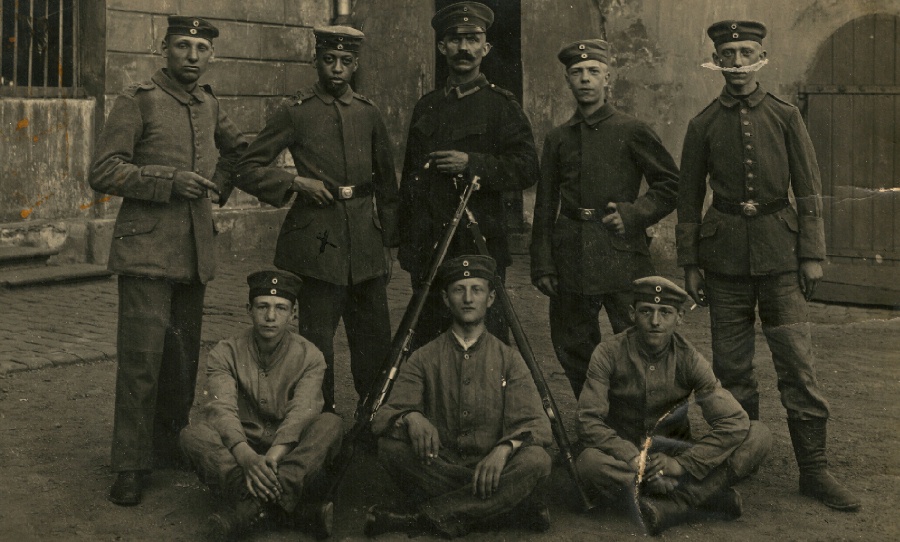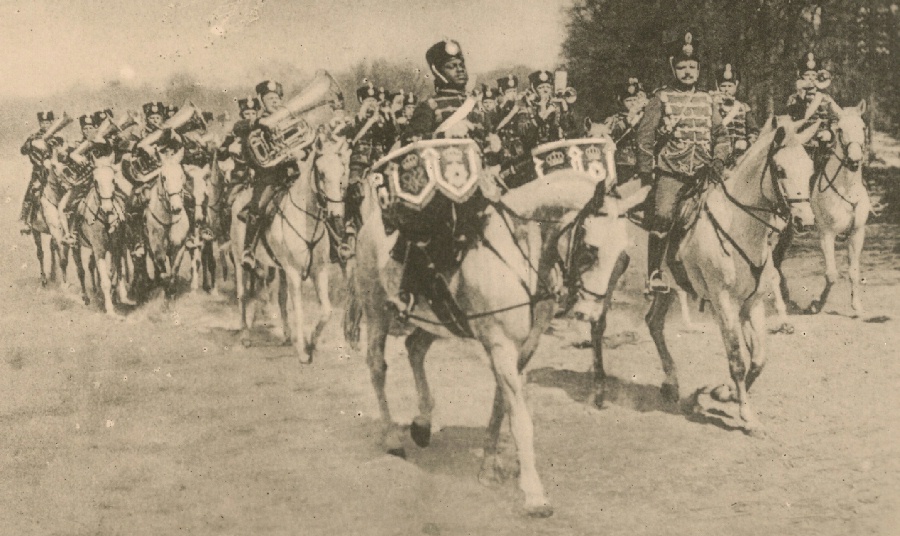|
It is unknown exactly how many Africans served in the Imperial German Army. Here
are notes on some others that are known: Josef Mambo
(born in 1885 in Tanga, East Africa) was brought to Germany as a child and later
served as the kettle drummer in the 3rd Prussian Horse Grenadiers ("Grenadier
Regiment zu Pferde 'Freiherr von Derfflinger' Nr. 3"). During the First
World War he was promoted through the ranks to Sergeant and was twice wounded,
once in Russia and once at Verdun. After the war he took part in the German
African Exhibition of the late 1930s where he was interviewed about his life: "Mambo,
that was the name of the black man we talked to. He told us of his native lands,
which he left when he was a child. In the year 1897 he was brought to Dresden by
a baron from Alsace and brought up as a foster child. He never saw East Africa again. Instead Mambo reached a
certain grade of fame in Germany, because from 1904 to 1913 he was the drummer
of the mounted grenadier regiment in Bromberg, to which he was assigned by the
Kaiser for the regiment's 200th anniversary. When the World War started, Mambo first
went to Russia and then to France with his old regiment. The Iron Cross second
class and Wound Medal show that he fulfilled his duty during the war."
Translated by from "Die Deutsche Afrika-Schau (1935-1940)" by Susann Lewerenz on
the Axis History Forum
Kwassi Bruce (born
in 1893 in Togo) was brought to Germany at the age of three by his father, JC Bruce
(born Nayo Friko) as part of a 100 strong group of African contract workers.
These men were
brought to Berlin in 1896 from all over the German colonies in Africa to
participate in the first German
Colonial Exhibition held between April and November 1896. Kwassi made his
living as a pianist in Berlin and during the First World War volunteered for
service. He saw action on the Western Front where he was captured and spent two
years in an allied Prisoner of War camp. It is possible that the photograph of a
German African being captured by French troops shown on the Axis History Forum
is Kwassi. After the war he returned to work as a pianist in Berlin. See his
letter quoted below about the hardships born by African Germans after the Nazi
Party came to power.
Heipold Jansen (born in 1893 in Duala,
Cameroon) lived in Germany and was a Vizefeldwebel in
the Prussian Army during the First World War. He later served in the Freikorps
against the Spartacus Rebellion in Berlin. It may be him in the famous
photograph seen on the Axis History Forum often mis-titled as being a loyal East
African in Munich.
Josef Bilé
(born in Cameroon) enlisted at the beginning of the First World War and trained at the garrison Meiningen, but was released
in January 1915 on account of a foot injury. After the war he worked in Germany
with International Red Aid, a communist organisation to help political prisoners.
Martin Paul Samba (1875-1914, born Mebenga M'Ebono in Kribi, Cameroon),
trained at the Prussian Military Academy in Potsdam from 1891. He was
commissioned as Leutnant and later promoted to Hauptmann. He left the army in
1894 and returned to Cameroon where he served on Hans Dominik's expeditions into
the unexplored depths of the colony. He took part in actions against several
tribes but gradually he turned against German rule. From 1912 he began to plan
an uprising. In July 1914 he was found with papers showing he was in touch with
the British and French to procure arms for a rebellion. He was tried and
executed by firing squad the following month.
Alexander Ndoumbe Duala Manga Bell (born
in Duala, Cameroon 1897-1966) of Duala Royalty was educated in Berlin and Kiel
and served briefly in the German Army. When the First World War broke out he was
in Germany. According to "The Royal Pretender" (by Joseph Richard) he fought in
the German army during the war. His father Rudolf Duala Manga Bell, was executed
in Cameroon August in August 1914 for plotting a rebellion against German rule.
After the war he home and later became Cameroon's first
elected representative in Paris under the new French rule of Cameroon During
the Second World War he served in the army in Senegal which was aligned with
Vichy. In the 1950s he represented Cameroon in the French National Assembly.
Johannes Arra Mensa from Togo trained at
the Prussian Military Academy in Potsdam. No other details are known about him.
Martin Dibobe
(born in 1876 in Cameroon) is not known to have served in the German army but
between 1906-20 worked for the Berlin Public Transport Company as one of the
first train drivers on the subway Line 1. A photograph of him in the uniform of
a train driver has appeared on the internet including the
Axis History Forum. This photograph has confused some readers into thinking
he was in an unidentified German army unit. In 1919 he wrote the Cameroon 32 Point
Petition to the Weimar Government.
Other Unidentified African German Soldiers
have been seen in period photographs. Wartime photographs of the 20th Saxon
Hussars, 20th Field Artillery and the 25th Landwehr Regiments show them with
individual African soldiers.

25th Landwehr
Regiment c1916-18
In this group photograph of "Landwehr-Infanterie-Regiment Nr. 25" an
African soldier is seen standing second left. The regiment was garrisoned in
Koblenz and the 1915 Tunic worn by two of the men, including the African, dates
the photograph to the latter half of the First World War.
Photo ©
Joe Robinson
After the First World War
In 1919 the Treaty of Versailles cut all ties between Germany
and her former colonies yet many of
these African Germans remained in post-war Germany. Some served in the Freikorps
and Reichswehr, many retained jobs as
musicians or entertainers. One former East African askari, Mohamed Hussein moved
from Africa to Germany and made his
name as a film actor.
When the Nazi party came to power in 1933 the
situation became very difficult for Germany's small African community. In August 1934 Kwassi Bruce
(a Western Front veteran born in Togo) wrote a letter to the Colonial Department
of the German Foreign Office describing life for Africans in Germany under the
Nazi Regime.
"After the National Government took
power, all Africans were required to present their passports and identity
documents respectively to be verified. Those who had not acquired German
citizenship through a naturalisation process had their hitherto recorded German
identification documents taken away and exchanged for 'alien' passports. Since
the beginning of the National Government we coloured, insofar as we earned our
own living as workers, have all, almost without exception, lost our positions
and engagements respectively. It has not been possible for us, even after
presenting proof of our origin from the former German colonies, to get new
employment.
I am a naturalised German (my passport has not yet been taken from me). During
the takeover of power by the national government, I played with my orchestra and
was director of the same in a good Berlin wine restaurant. My position was
permanent. Last March, the owner of the business told me that he regretted that
he would nor be able to employ me further with my orchestra because we were
coloured. On the 1st April, I had to stop and tried to find a new engagement in
vain.
Wherever I asked about employment, I was told that they regretted that they
would not be able to employ me because I was coloured. When I referred to my
heritage from the former German protectorate of Togo, I received the following
answers: "Yes, we don't have colonies anymore", or "Negroes are not allowed to
be employed anymore", or "The public doesn't want to see any more Negroes, we
have to take the wishes of the guests into account". Even my participation in
the World War on the side of the Germans as a war volunteer as well as two years
as a prisoner of war couldn't convince any employer to hire me."
The situation worsened for Africans inside Hitler's Reich. Unlike the Jewish
people, there were no specific laws passed against Africans. Even so, many were
forcibly sterilised and others some were sent to concentrations camps (including
Mohamed Hussein, the former East African askari). Hitler's Breslau speech of
1938 warned all non-Aryans to leave Germany. Many German Africans could not
leave as they only had German nationality. There are no accurate figures for the
number of Africans that died in the Nazi
Holocaust.
Links and Recommended Sources
Most of the information for this article
originated from a discussion on
Africans in the Imperial German Army on the Axis History Forum including
figures from the Bundesarchiv records. Thank you very much to all the very
helpful people who contributed towards that thread.
Other photographs of African German soldiers were
found at the
Desert Column Forum (20th Hussars), the
Gentlemen's
Military Interest Club (20th Field Artillery) and the
Joe Robinson Collection.
Discussion on Gustav Sabac El Cher at the GMIC
Article on Gustav Sabac El Cher at the DHM
Black Germans
Do Not Exist article on the Free Library including the Kwassi Bruce letter,
quoted above.
Erstes-Garderegiment for biographical information on Ben Aissa
"Die Deutsche Afrika-Schau (1935-1940)" by Susann Lewerenz
for the quote above about Josef Mambo.
The Royal Pretender : Prince Douala Manga Bell in Paris, 1919-1922 by
Richard Joseph for a biography of Alexander Douala Manga Bell.
Martin-Paul Samba
on Wikipedia.
Hessians in the
American War article on the Von Donop website.

Kettledrummer Elo Sambo
leads the band of the Prussian Life Guard Hussars
Photo ©
Joe Robinson
|